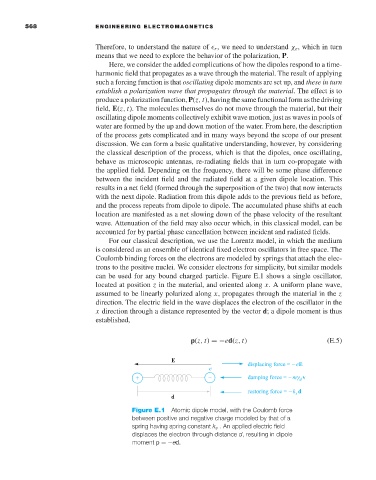Page 586 - Engineering Electromagnetics, 8th Edition
P. 586
568 ENGINEERING ELECTROMAGNETICS
Therefore, to understand the nature of r ,we need to understand χ e , which in turn
means that we need to explore the behavior of the polarization, P.
Here, we consider the added complications of how the dipoles respond to a time-
harmonic field that propagates as a wave through the material. The result of applying
such a forcing function is that oscillating dipole moments are set up, and these in turn
establish a polarization wave that propagates through the material. The effect is to
produce a polarization function, P(z, t), having the same functional form as the driving
field, E(z, t). The molecules themselves do not move through the material, but their
oscillating dipole moments collectively exhibit wave motion, just as waves in pools of
water are formed by the up and down motion of the water. From here, the description
of the process gets complicated and in many ways beyond the scope of our present
discussion. We can form a basic qualitative understanding, however, by considering
the classical description of the process, which is that the dipoles, once oscillating,
behave as microscopic antennas, re-radiating fields that in turn co-propagate with
the applied field. Depending on the frequency, there will be some phase difference
between the incident field and the radiated field at a given dipole location. This
results in a net field (formed through the superposition of the two) that now interacts
with the next dipole. Radiation from this dipole adds to the previous field as before,
and the process repeats from dipole to dipole. The accumulated phase shifts at each
location are manifested as a net slowing down of the phase velocity of the resultant
wave. Attenuation of the field may also occur which, in this classical model, can be
accounted for by partial phase cancellation between incident and radiated fields.
For our classical description, we use the Lorentz model, in which the medium
is considered as an ensemble of identical fixed electron oscillators in free space. The
Coulomb binding forces on the electrons are modeled by springs that attach the elec-
trons to the positive nuclei. We consider electrons for simplicity, but similar models
can be used for any bound charged particle. Figure E.1 shows a single oscillator,
located at position z in the material, and oriented along x.A uniform plane wave,
assumed to be linearly polarized along x, propagates through the material in the z
direction. The electric field in the wave displaces the electron of the oscillator in the
x direction through a distance represented by the vector d;a dipole moment is thus
established,
p(z, t) =−ed(z, t) (E.5)
Figure E.1 Atomic dipole model, with the Coulomb force
between positive and negative charge modeled by that of a
spring having spring constant k s .An applied electric field
displaces the electron through distance d,resulting in dipole
moment p =−ed.

